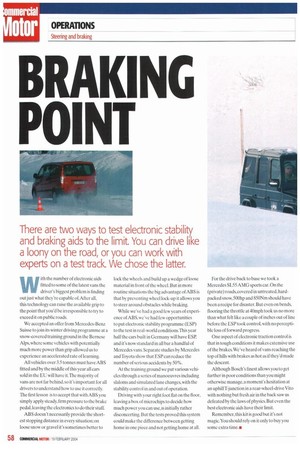1
Page 60

If you've noticed an error in this article please click here to report it so we can fix it.
NG POINT
There are two ways to test electronic stability and braking aids to the limit. You can drive like a loony on the road, or you can work with experts on a test track. We chose the latter.
With the number of electronic aids fitted to some of the latest vans the driver's biggest problem is finding out just what they're capable of. After all, this technology can raise the available grip to the point that you'd be irresponsible to try to exceed it on public roads.
We accepted an offer from Mercedes-Benz Suisse to join its winter driving programme at a snow-covered training ground in the Bernese Alps, where some vehicles with potentially much more power than grip allowed us to experience an accelerated rate of learning.
All vehicles over 3.5 tonnes must have ABS fitted and by the middle of this year all cars sold in the EU will have it.The majority of vans are not far behind.so it's important for all drivers to understand how to use it correctly. The first lesson is to accept that with ABS you simply apply steady, firm pressure to the brake pedal, leaving the electronics to do their stuff.
ABS doesn't necessarily provide the shortest stopping distance in every situation on loose snow or gravel it's sometimes better to lock the wheels and build up a wedge of loose material in front of the wheel. But in more routine situations the big advantage of ABS is that by preventing wheel lock-up it allows you to steer around obstacles while braking.
While we've had a good few years of experience of ABS, we've had few opportunities to put electronic stability programme (ESP) to the test in real-world conditions. This year half the cars built in Germany will have ESP, and it's now standard in all bar a handful of Mercedes vans. Separate studies by Mercedes andToyota show that ESP can reduce the number of serious accidents by 50%.
At the training ground we put various vehicles through a series of manoeuvres including slaloms and simulated lane changes, with the stability control in and out of operation.
Driving with your right foot flat on the floor, leaving a box of microchips to decide how much power you can use, is initially rather disconcerting. But the tests proved this system could make the difference between getting home in one piece and not getting home at all. For the drive back to base we took a Mercedes SL55 AMG sports car. On the (private) roads, covered in untreated, hardpacked snow.500hp and 850Nin should have been a recipe for disaster. But even on bends, flooring the throttle at 40mph took us no more than what felt like a couple of inches out of line before the ESP took control, with no perceptible loss of forward progress.
One aspect of electronic traction control is that in tough conditions it makes extensive use of the brakes.We've heard of vans reaching the top of hills with brakes as hot as if they'd made the descent.
Although Bosch's finest allows you to get further in poor conditions than you might otherwise manage. a moment's hesitation at an uphillT-junction in a rear-wheel-drive Vito with nothing but fresh air in the back saw us defeated by the laws of physics. But even the best electronic aids have their limit.
Remember, this kit is good but it's not magic. You should rely on it only to buy you some extra time.•






































































































































































































